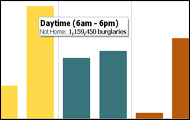
The stereotypical burglary of the unknown masked man armed with a gun, breaking into a house and violently attacking its residents, is usually not the case, according to a new Bureau of Justice Statistics report that uses a revised definition of burglary to assess burglary-related violence.
While burglary is usually defined as a property crime, it is categorized as a personal crime when someone is at home and attacked or threatened during that burglary. In the report, "Victimization During Household Burglary," researchers identified all burglaries, violent or not, in the burglary category, so as to evaluate the quantity and demographic breakdowns of burglary violence.
What researchers found was that violence was used on average in seven percent (266,560) of the 3.7 million burglaries each year. Of those 266,560 violent burglaries, offenders had a firearm just 12 percent of the time, and victims knew their attackers beforehand 65 percent of the time.
The most common type of violence was simple assault, followed by robbery and rape. In these cases, 36 percent were identified as minor injury and nine percent as serious injury.
Use the interactive chart below to track household burglary trends from 2003-2007:
Overall, the number of violent burglaries has increased, remaining relatively stable between 2000 and 2005 at 6.3 percent and 5.7 percent respectively, but rising two percentage points from 5.7 to 7.7 percent between 2005 and 2007.
Most, Least Likely to be Burglarized While at Home?
The study also broke down who is at a higher and lower risk of having their home burglarized while they are there. The least likely were married couples without kids. They were also less likely to get burglarized while they weren't home. The most likely was single female heads of households with kids.
By race/ethnicity, and age, American Indians/Alaska Natives had the highest rate of both burglaries when they were at home and away, while the least likely were Asian/Pacific Islanders. And when the head of household was 12-19 years old, they were much more likely to be home during a burglary, compared to the least likely people who were 65 and up.
(BJS: Victimization During Household Burglary) PDF
Suzette Lohmeyer is a staff writer for State of the USA.
Data visualization by Anthony Calabrese of State of the USA.